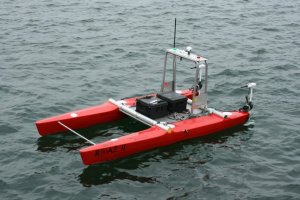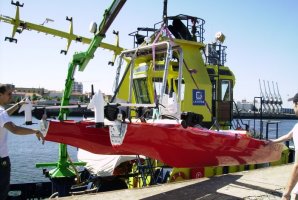| Quick Links | |
|
PCMMC : Perception-Driven Coordinated Multi-Robot Motion Control Project |
|
| With support from | |
|
|
|
ROAZ II is autonomous surface vehicle designed for ocean operations, namely oceanographic, bathymetry, security and search and rescue support operations.
The robot was designed to support research in marine robotic systems. Part of the ROAZ marine surface robotics research program, it allows the validation test and prove of concept for developments in control, multiple vehicle coordination, navigation, sensing and other related areas applied to surface robots.


The ROAZ II system followed a catamaran design and was developed in order to allow full open sea operations. The two high density polyethylene (HDPE) hulls are connected by transversal aluminum tubes with a supporting stainless steel platform. The overall vehicle weight is around 200 kg and has 4.5 meters long for 2.2 meters width and 0.5 meters height.
The on-board computational system, embedded thruster control unit and several navigation sensor electronics are housed in one of two watertight boxes mounted on the central platform. The other houses four 12V AMG batteries providing 24V and 12V power capability.
Two Minnkota trolling motors providing 22 kilograms of bollard pull each achieve vehicle propulsion.
On a raised bridge the vehicle has a WIFI 802.11 a/b/g antenna for communications, a 2.4Ghz wireless video link, GPS antenna and vision system. The vision sensors are a day/night video camera and a thermographic infrared camera.
Attached to the central structure and deployed in the water the vehicle has a retractable sensor fixing mechanism allowing the use of underwater sensors such as a sidescan sonar or sonar altimeter.
ROAZ II have been tested in operational scenario, in various missions ranging from security and inspection to bahtymetry on Leixões Harbour and in the portuguese north coast.


